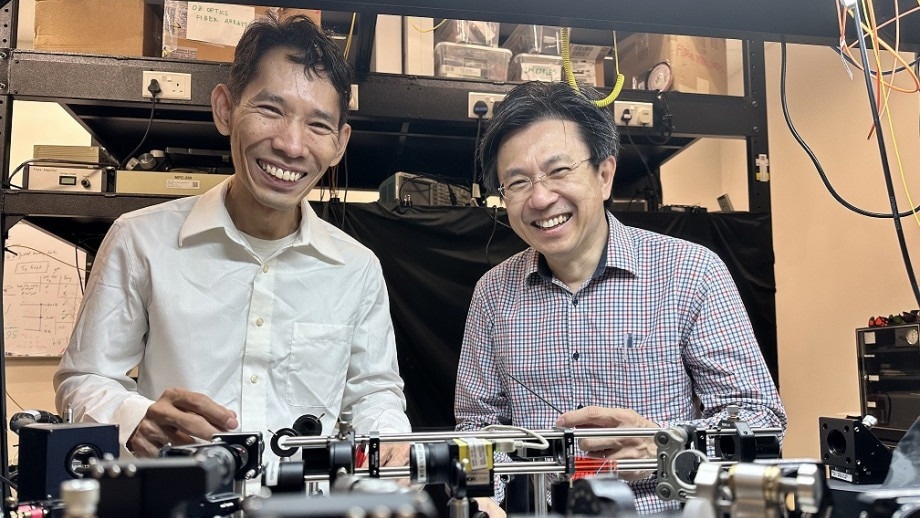At the Australian National University (ANU), a new study headed by a research group has described an approach to achieve highly precise measurements of microscopic objects with the help of quantum computers.
 Dr. Syed Assad and Professor Ping Koy Lam. Image Credit: Valerie Wong, A-Star Institute of Materials Research and Engineering
Dr. Syed Assad and Professor Ping Koy Lam. Image Credit: Valerie Wong, A-Star Institute of Materials Research and Engineering
It is a step that could prove beneficial in an extensive range of next-generation technologies, such as biomedical sensing.
Analyzing the various individual properties of a large daily object like a car is quite simple: a car consists of a well-specified position speed and color. However, this gets much more complicated while trying to analyze microscopic quantum objects like photons, known to be small particles of light.
That is due to some properties of quantum objects linked, and quantifying one property could disturb the other. For instance, quantifying the position of an electron will impact its speed and vice versa.
Such properties are known as conjugate properties, a direct manifestation of the well-known uncertainty principle of Heisenberg. It is impossible to concurrently quantify two conjugate properties of a quantum object with arbitrary precision.
According to study lead author and ANU Ph.D. researcher Lorcán Conlon, this is one of the defining difficulties of quantum mechanics.
We were able to design a measurement to determine conjugate properties of quantum objects more accurately. Remarkably, our collaborators were able to implement this measurement in various labs around the world.
Lorcán Conlon, Study Lead Author and Ph.D. Researcher, Australian National University
Conlon added, “More accurate measurements are crucial, and can in turn open up new possibilities for all sorts of technologies, including biomedical sensing, laser ranging, and quantum communications.”
The new method involves a weird quirk of quantum systems called entanglement. As per the scientists, by entangling two similar quantum objects and quantifying them collectively, it becomes possible for researchers to identify their properties more accurately compared to if they were quantified separately.
By entangling two identical quantum systems, we can acquire more information. There is some unavoidable noise associated with measuring any property of a quantum system. By entangling the two, we're able to reduce this noise and get a more accurate measurement.
Dr. Syed Assad, Study Co-Author, Australian National University
As far as theory is concerned, it is possible to entangle and quantify three or more quantum systems to achieve even better accuracy. However, in this case, the experiments could not be agreed with the theory. Still, the authors are positive that future quantum computers will be able to defeat such limitations.
Quantum computers with error-corrected qubits will be able to gainfully measure with more and more copies in the future.
Lorcán Conlon, Study Lead Author and Ph.D. Researcher, Australian National University
According to Ping Koy Lam, Professor at ANU and A*STAR chief quantum scientist at the Institute of Materials Research and Engineering (IMRE), one of the main strengths of this work is that a quantum enhancement could still be observed in noisy scenarios.
Ping Koy Lam stated, “For practical applications, such as in biomedical measurements, it is important that we can see an advantage even when the signal is inevitably embedded in a noisy real-world environment.”
The study was performed by experts at the ARC Centre of Excellence for Quantum Computation and Communication Technology (CQC2T) in partnership with scientists from A*STAR’s Institute of Materials Research and Engineering (IMRE), the University of Jena, the University of Innsbruck, and Macquarie University.
Amazon Web Services cooperated by offering research and architectural support, and by making available the Rigetti Aspen-9 device utilizing Amazon Braket.
The scientists tested their theory on 19 different quantum computers, throughout three different platforms: trapped ion, superconducting, and photonic quantum computers.
Such world-leading devices are situated across America and Europe and are cloud-accessible. This enables scientists from across the globe to connect and perform essential research.
Journal Reference:
Conlon, L. O., et al. (2022) Approaching optimal entangling collective measurements on quantum computing platforms. Nature Physics. doi.org/10.1038/s41567-022-01875-7.